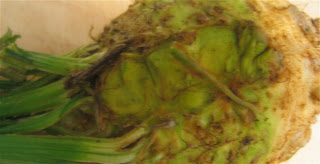 I woke up yesterday morning and immediately wrapped myself tighter around my comforter. Yes, finally the cold hit and my heat had not yet been turned on. Anyone who knows me will attest to my low threshold for the cold – so for me anything below 70-degrees starts a cooling trend. Why I don’t live in a more temperate climate is another conversation.
I woke up yesterday morning and immediately wrapped myself tighter around my comforter. Yes, finally the cold hit and my heat had not yet been turned on. Anyone who knows me will attest to my low threshold for the cold – so for me anything below 70-degrees starts a cooling trend. Why I don’t live in a more temperate climate is another conversation. As I rallied myself to get up, and run to a hot shower I knew this was a day for cooking. Especially, since my heat was not yet rattling its way through the pipes I knew a long simmering “something” would warm more than a carving. Sipping my coffee wearing socks, for the first since last winter, I started to take stock of the kitchen larder. I was not quite ready to break into any of the items I’d put-up over the summer – not while the market still supplies plenty of foods. But I did have garlic and onions in ample reserve in the refrigerator and I just happen to have bought some yucca – why? They looked to good to pass up.
If you are not familiar with yucca you might know it as cassava or manioc a tuber coming out of the Amazonian Basin that is a staple throughout the tropical parts of the world. It is also the vegetable that we derive tapioca from – everyone has eaten a version at sometime. Be warned that one pound of yucca packs about 650 calories – an energy rich food store. Keep in mind it does take more calories to stay warm, so I had no problems with a potent pot cooking away. After the gym I stopped at the store to consider what meat will inform my yucca. It’s me, whom are we kidding? I bought a piece of boneless pork shoulder and a bunch of celery – that is all I would need.
A few hours later I had a braise of broken-down pork and chunks of yucca spiked with a squeeze of lime. I rested bowl on my chest warming both my outer and inner selves.
I woke this morning to the clang and hiss of winter’s soundtrack – my heat was on its way.

Pork and Yucca – yields 6 to 8 servings
1/4-cup olive oil
3 pounds boneless pork shoulder – trimmed of excess fat
3 onions – cut into large chunks
1-bunch celery – cut into 1/2-inch pieces
1 head garlic – peeled and roughly chopped
1 chili pepper – such as habanero or jalapeno; minced
1-teaspoon whole cumin seed
1-teaspoon whole coriander seed
1-tablespoon smoked paprika
2 whole black cardamom pods
1/4-cup fresh thyme leaves
1 pound yucca – peeled and cut into 1-inch pieces
Salt and pepper to taste
Heat a 10-quart Dutch oven or casserole dish over a high heat. Add the oil, and pork shoulder. Sear the shoulder on all sides to very brown and crisp. Remove from the pot, and hold in a clean bowl.
Add the onion, celery and chili to the pot. Lower then heat to medium and cook the onion mixture for 10 to 15 minutes, stirring every so often. Return the pork to the pot along with the thyme. Season with salt and pepper, and pour in a cup of water. Reduce the heat to low, and cover. Cook the pork for 2 hours. Checking to make sure it is not to dry – add some water if necessary.
After 2 hours add the yucca and cook for an hour longer. Correct seasoning.






























